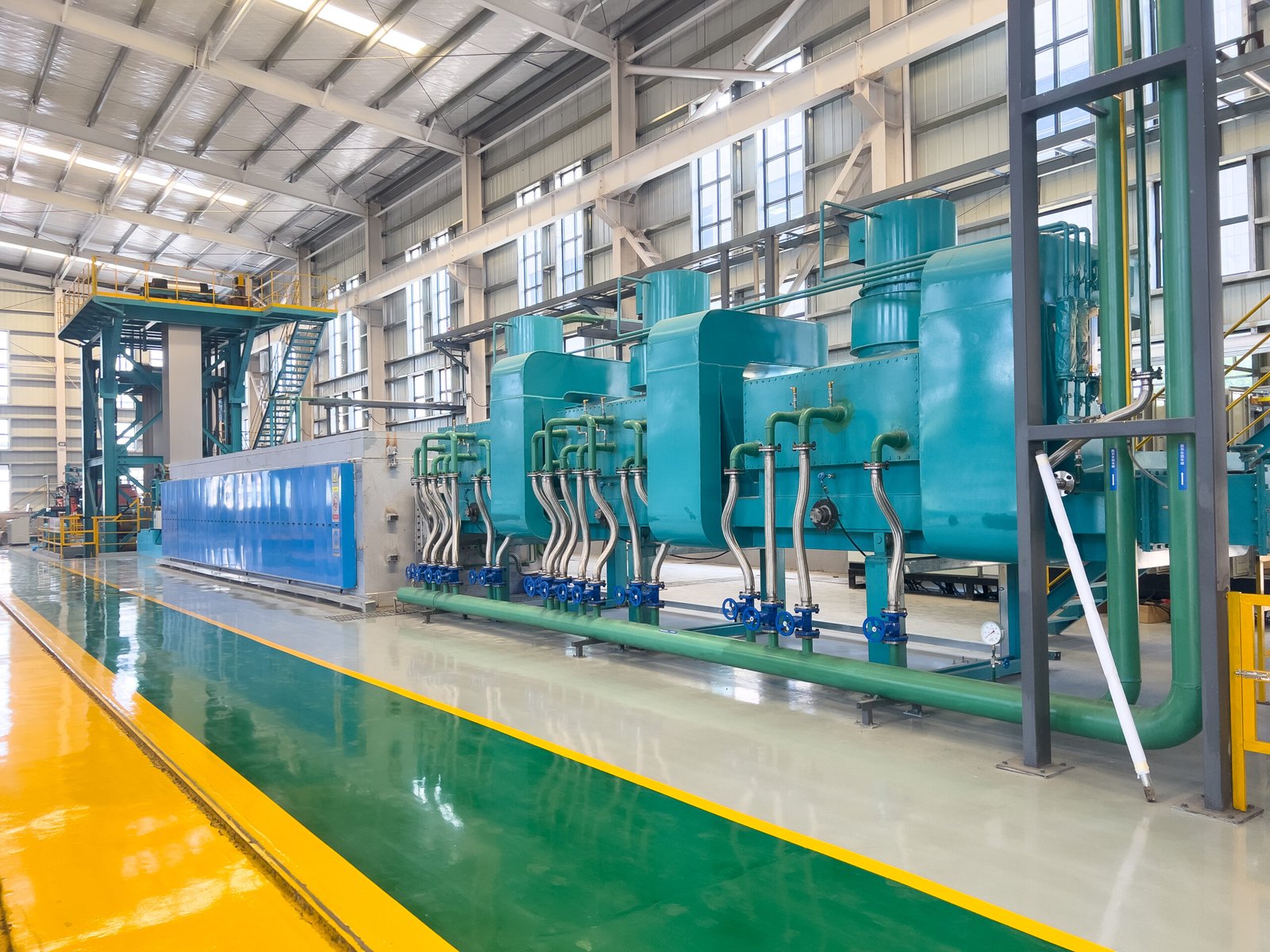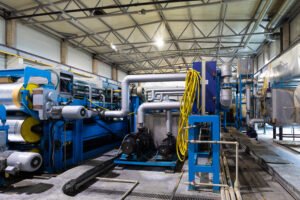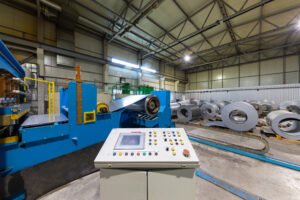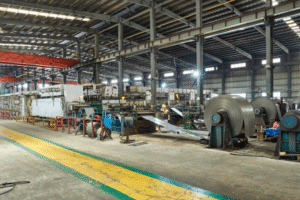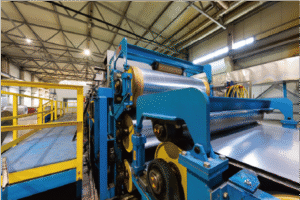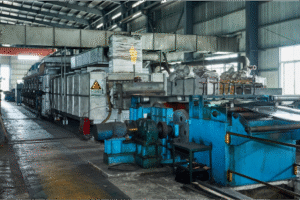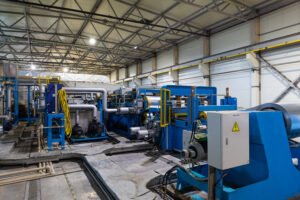How Bright Annealing Supports Sustainable Manufacturing Goals

Are you grappling with the environmental impact and operational costs of traditional annealing methods? Many manufacturers find that conventional heat treatment processes are energy-intensive and generate significant waste, putting pressure on both sustainability targets and profit margins. Bright annealing technology offers a cleaner, more efficient pathway to achieving your sustainable manufacturing objectives.
Bright annealing contributes to sustainable manufacturing by minimizing surface oxidation through controlled atmospheres, thereby reducing or eliminating the need for chemical pickling, conserving energy via efficient furnace designs, and improving material yield. This directly supports eco-friendly metal processing goals and operational efficiency.
As industries worldwide intensify their focus on greener practices, understanding how specific technologies like bright annealing can be integrated into a sustainable manufacturing framework becomes paramount. This isn't merely about adhering to new regulations; it’s about future-proofing your operations, enhancing your brand's reputation, and often, unlocking considerable cost savings. Let's explore this further.
The global push towards sustainability is reshaping industries, and manufacturing is at the forefront of this transformation. Heat treatment, a historically energy-intensive process, presents a significant opportunity for improvement. At AKS Furnace, we've observed a clear trend: our clients, from stainless steel strip processors in Southeast Asia to automotive component manufacturers in Europe, are increasingly seeking solutions that not only meet their production needs but also align with stringent environmental standards. This shift is driven by a combination of regulatory pressures, such as carbon emission targets and stricter waste disposal laws, and market demands for greener products. Moreover, resource efficiency, reduced operational costs, and enhanced corporate social responsibility are powerful internal motivators. Bright annealing, by its very nature, addresses several key sustainability pillars: resource conservation, pollution prevention, and energy efficiency, making it a critical technology in the evolution towards a more sustainable industrial future.
Background of Sustainable Manufacturing and Its Importance
Feeling overwhelmed by the term "sustainable manufacturing" or unsure how it directly impacts your metal processing business? It's easy to see it as just another industry buzzword, yet it represents a fundamental shift in how successful, future-proof businesses operate, affecting everything from resource management to market competitiveness. Understanding its core principles and profound importance is the first step toward leveraging its significant benefits for your company.
Sustainable manufacturing is an operational philosophy centered on minimizing negative environmental impacts while conserving energy and natural resources, and ensuring safe products and communities. Its importance lies in fostering long-term ecological balance, enhancing economic viability through efficiency, and promoting social equity within industrial practices.
The journey towards sustainable manufacturing is far more than an ethical consideration; it's rapidly evolving into a cornerstone of competitive advantage and operational resilience in the global marketplace. For us at AKS Furnace, this isn't just a theoretical concept. We engage daily with clients who are actively embedding sustainability into their core strategies. Take, for example, a medium-sized enterprise in India specializing in copper strip production. They initially approached us focused on improving product finish, but our discussions quickly broadened to how a new bright annealing line could drastically reduce their reliance on pickling acids, thereby cutting hazardous waste disposal costs and improving their local environmental impact. This scenario is becoming increasingly common. Companies are recognizing that sustainable practices lead to tangible benefits: reduced operational expenses through lower energy and material consumption, enhanced brand image attracting environmentally conscious consumers and talent, and improved compliance with ever-tightening international regulations. This shift reflects a deeper understanding that the long-term health of our planet and the prosperity of our businesses are inextricably linked. Metal processing, traditionally an energy-intensive sector, is at a crucial juncture. The decisions we make today regarding our processes—from raw material sourcing to final heat treatment—will have lasting implications. Embracing sustainability means a commitment to rethinking conventional methods, investing in innovative technologies like our energy-efficient bright annealing furnaces, and cultivating a culture of continuous improvement focused on environmental stewardship.

The concept of sustainability in manufacturing has evolved significantly over the decades, moving from a reactive stance on pollution control to a proactive, integrated strategy for long-term value creation. This evolution reflects a growing understanding of the interconnectedness of environmental health, social well-being, and economic prosperity. For businesses in the metal processing sector, grasping this evolution and its current drivers is crucial for strategic planning and investment. The importance of sustainable manufacturing cannot be overstated; it's the bedrock upon which future industrial success will be built, ensuring not only environmental compliance but also market relevance and operational excellence. At AKS Furnace, we've seen our clients increasingly prioritize solutions that offer both superior performance and a reduced environmental footprint, signaling a fundamental shift in industry values. This transition involves a deeper dive into process efficiencies, material lifecycle management, and the adoption of cleaner technologies, all aimed at creating a more resilient and responsible manufacturing ecosystem.
The Evolution of "Green" in Manufacturing
The journey towards what we now call sustainable manufacturing began with rudimentary, often reactive, environmental controls. Initially, in the mid to late 20th century, the primary focus was on "end-of-pipe" solutions – treating pollutants after they were generated. Think smokestack scrubbers and wastewater treatment plants. While necessary, this approach didn't address the root causes of pollution or resource inefficiency. I recall early discussions in the industry where environmental compliance was often seen purely as a cost center, a necessary evil to meet burgeoning regulations.
The paradigm began to shift in the late 20th and early 21st centuries towards pollution prevention (P2) and resource efficiency. Companies started realizing that reducing waste at the source could actually save money. This era saw the rise of concepts like lean manufacturing, which, while primarily focused on operational efficiency, had inherent environmental benefits through reduced waste and energy consumption. The focus broadened from just pollution to encompass minimizing the use of raw materials, water, and energy. This was a significant step, as it started to align environmental goals with economic incentives.
Today, sustainable manufacturing embodies a holistic 'Triple Bottom Line' (TBL) approach1, considering People, Planet, and Profit. It’s not just about minimizing harm but about creating positive value across all three dimensions. This means ensuring worker safety and community well-being (People), protecting and restoring ecosystems (Planet), and maintaining long-term economic viability (Profit). ESG (Environmental, Social, and Governance) criteria are now major factors in investment decisions, with a 2021 report by Bloomberg Intelligence projecting that global ESG assets could exceed $53 trillion by 20252, making up more than a third of total assets under management. This clearly indicates that sustainability is no longer a niche concern but a mainstream business imperative.
Key Drivers Pushing Industries Towards Sustainability
Several powerful forces are compelling industries, particularly metal processing, to adopt more sustainable practices. Firstly, regulatory pressures are intensifying globally. Governments are implementing stricter emissions standards (like the EU's Carbon Border Adjustment Mechanism - CBAM3), carbon pricing schemes, and regulations on waste disposal and chemical usage. For instance, REACH regulations in Europe heavily influence the types of chemicals that can be used in manufacturing processes, directly impacting operations like pickling. We've worked with clients, such as an automotive parts supplier in Germany, who proactively upgraded their annealing facilities to AKS bright annealing lines to preemptively meet future emissions targets and reduce their reliance on regulated chemical treatments, thereby safeguarding their market access.
Secondly, consumer demand and brand reputation play a significant role. A 2021 study by Simon-Kucher & Partners found that 34% of global consumers are willing to pay a premium for sustainable products, and this trend is growing. Companies recognized for their sustainable practices often enjoy enhanced brand loyalty and a stronger market position. This is particularly true for businesses exporting to developed markets where consumer awareness of environmental issues is high. I remember a client manufacturing stainless steel kitchenware who found that highlighting their investment in bright annealing and the resultant elimination of harsh chemical cleaning processes significantly boosted their appeal to North American retailers focused on eco-friendly products.
Thirdly, cost savings derived from resource efficiency are a major driver. Sustainable practices inherently involve optimizing the use of energy, water, and raw materials, leading to direct reductions in operational expenditures. For example, reducing material loss from scaling by using bright annealing can lead to substantial savings on expensive alloys. Similarly, minimizing waste reduces disposal costs, which are often escalating. Finally, supply chain resilience is increasingly linked to sustainability. Concerns about resource scarcity, price volatility of raw materials, and the impacts of climate change are pushing companies to adopt circular economy principles and diversify their sourcing, often favoring suppliers with strong sustainability credentials.
The Indispensable Role of Manufacturing in a Sustainable Future
Manufacturing is a cornerstone of the global economy, but it also has a substantial environmental footprint, accounting for a significant portion of global energy consumption (around 54% according to some estimates when including industrial energy use) and greenhouse gas emissions (approximately 20% directly from industry, with more from energy production for industrial use). This means the sector bears a great responsibility but also holds immense potential to drive the transition to a sustainable future.
The shift towards a circular economy, where products are designed for durability, repairability, and recyclability, and materials are kept in use for as long as possible, is heavily reliant on innovations in manufacturing. Metal processing, in particular, plays a vital role due to the high recyclability of most metals. Practices like designing components for easy disassembly or using alloys that are simpler to recycle contribute significantly. For instance, our bright annealing furnaces ensure a clean, uncontaminated surface, which can improve the quality and ease of recycling for metal products at their end-of-life.
Technological innovation is the primary enabler for sustainable manufacturing. Advances in furnace technology, process control, material science, and data analytics are allowing manufacturers to produce more with less environmental impact. From energy-efficient heating systems in our AKS furnaces to AI-driven predictive maintenance that minimizes downtime and resource wastage, technology is key. The industry's commitment to R&D, as seen in our own focus at AKS on developing even more energy-efficient and precise heat treatment solutions, is crucial for pushing the boundaries of what's possible in sustainable production. Manufacturing isn't just a part of the sustainability problem; it's an indispensable part of the solution.
| Metric | Traditional Manufacturing | Sustainable Manufacturing |
|---|---|---|
| Resource Focus | High consumption | Optimized use, circularity |
| Energy Use / Unit | Typically higher | Minimized, renewable sources prioritized |
| Waste Generation / Unit | Significant | Minimized, valorized, or designed out |
| Emissions (GHG, VOCs) | Often unmitigated | Actively reduced, captured, or eliminated |
| Lifecycle Perspective | Cradle-to-grave | Cradle-to-cradle or cradle-to-recycling |
| Primary Goal | Maximize output/profit | Balance profit, planet, people (Triple Bottom Line) |
| Chemical Use | Often extensive | Reduced, safer alternatives sought |
| Water Consumption | High, open-loop systems | Minimized, closed-loop systems, recycled water |
Bright annealing reduces chemical picklingTrue
Bright annealing's controlled atmosphere minimizes surface oxidation, significantly reducing or eliminating the need for chemical pickling processes.
Sustainability is just about regulationsFalse
Sustainable manufacturing encompasses far more than compliance - it includes cost savings, brand reputation, and operational resilience through efficient resource use.
Current Practices in Sustainable Metal Processing
Are you wondering how the broader metal processing industry is tackling sustainability? It's easy to assume that this heavy industry lags behind, but many current practices fall short, leading to unnecessary waste and pollution, prompting a wave of innovation. Now is the time to discover the advanced approaches and technologies that are redefining eco-friendly metal treatment and setting new benchmarks.
Current sustainable metal processing practices focus on optimizing energy consumption in furnaces, implementing closed-loop water recycling systems, drastically reducing hazardous waste from processes like pickling, increasing the recycling rates of metals and by-products, and adopting advanced surface treatment technologies, such as bright annealing, that inherently minimize environmental impact.
The metal processing industry, a foundational pillar of modern manufacturing, has historically been characterized by its high energy demands and considerable environmental footprint. However, a significant transformation is currently underway. This shift is propelled by a powerful combination of stringent regulatory pressures, evolving market expectations for greener products, and a deepening commitment to corporate social responsibility. Companies across the sector are no longer just making incremental improvements; they are fundamentally re-evaluating and redesigning their processes to achieve genuine ecological and economic sustainability. This comprehensive approach spans the entire value chain, from the responsible sourcing of raw materials and meticulous optimization of each production stage, to the thoughtful management of products at their end-of-life. Innovation is at the heart of this movement. At AKS Furnace, we've had the privilege of collaborating with numerous clients who are at the vanguard of this transition. For instance, a stainless steel strip producer in Southeast Asia, a key export market for us, recently adopted one of our advanced Bright Annealing Furnaces. Their goal was not only to enhance surface quality for their high-grade products but also to significantly reduce their dependence on post-annealing chemical cleaning, thereby cutting down on hazardous waste and improving their local environmental credentials. Their success story, and many others like it, vividly demonstrate that sustainable metal processing is not a far-off aspiration but a tangible, achievable reality. These pioneering efforts are paving the way for a cleaner, more efficient, and ultimately more profitable future for the entire metal processing sector, emphasizing a lifecycle perspective where environmental impact is considered from cradle to grave—or, ideally, from cradle to cradle, fostering a truly circular economy for metals4.
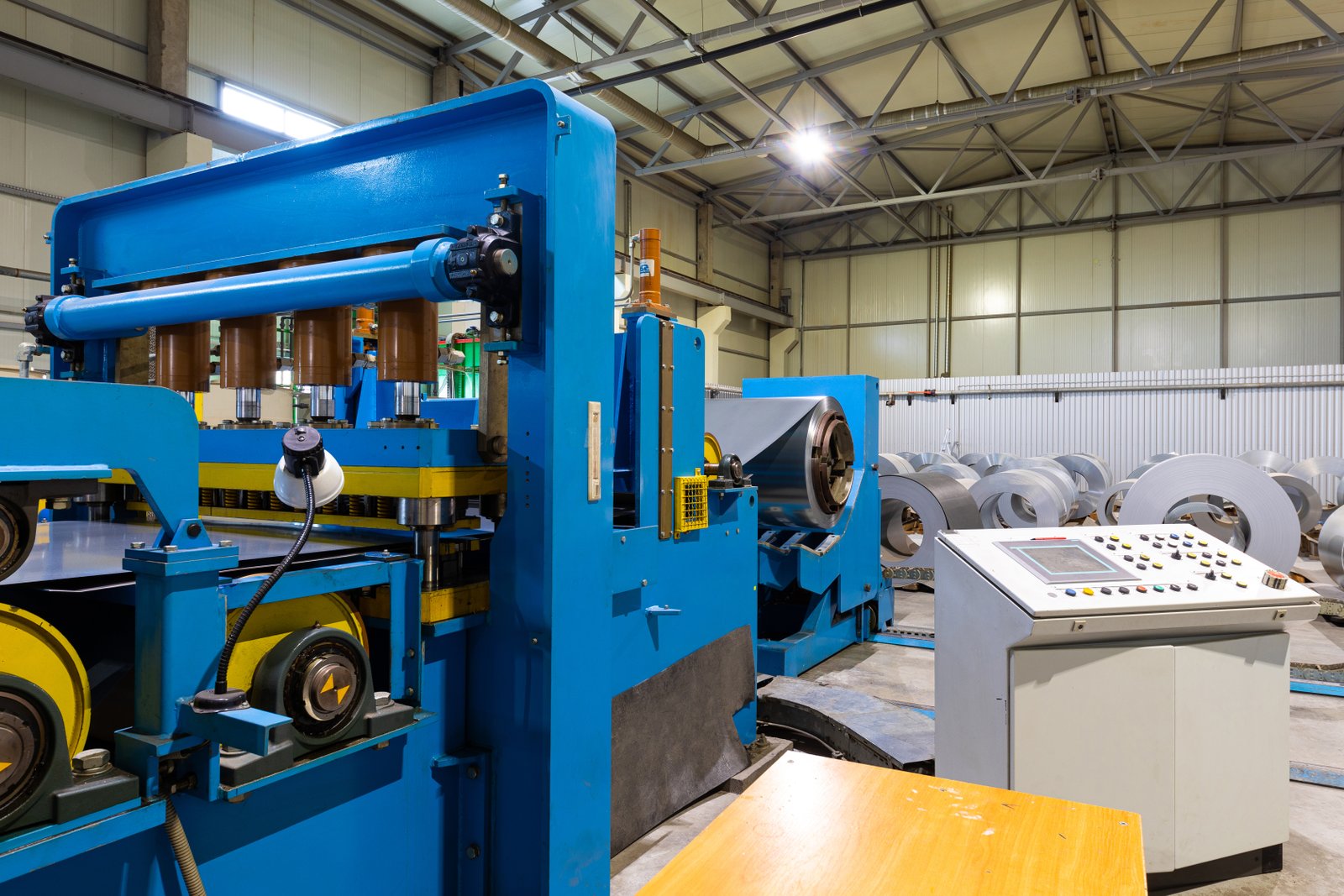
The pursuit of sustainability in metal processing is multifaceted, involving a concerted effort to improve efficiencies, reduce environmental impact, and enhance social responsibility. Key areas of focus include optimizing energy usage, managing water resources effectively, minimizing waste generation, and embracing circular economy principles. These practices are not just about compliance; they represent strategic investments that can lead to significant cost savings, improved brand reputation, and enhanced competitiveness in a global market that increasingly values environmental stewardship. At AKS Furnace, our product development, including our specialized bright annealing furnaces, is intrinsically linked to these sustainable practices. We aim to provide solutions that help our clients, such as carbon steel strip heat treatment plants or copper and brass strip mills, achieve their production goals while simultaneously advancing their sustainability objectives. The industry's move towards greener operations is evident in the adoption of cleaner technologies, the emphasis on material lifecycle management, and a growing culture of environmental awareness across the supply chain.
Energy Efficiency and Optimized Resource Utilization
A primary focus in sustainable metal processing is the drastic reduction of energy consumption. Furnaces, being significant energy consumers, are a key target for optimization. Modern furnace designs, such as those we develop at AKS, incorporate advanced insulation materials, high-efficiency heating elements (like optimized radiant tubes or electric elements), and sophisticated combustion control systems for gas-fired units to minimize heat loss and maximize thermal transfer. For example, our Bright Annealing Furnaces are designed with muffle or retort systems that allow for precise atmosphere control while ensuring efficient heating of the material. According to data from the U.S. Department of Energy, industrial heating systems can often achieve energy savings of 10% to 30% through upgrades and optimization. I recall a client, a large carbon steel strip processor in India, who, after retrofitting their older annealing line with a more modern continuous furnace from AKS featuring better insulation and a recuperative burner system, reported a natural gas consumption reduction of nearly 22% per ton of steel processed.
Beyond the furnace itself, waste heat recovery systems5 are becoming standard practice. Heat exchangers can capture thermal energy from exhaust flue gases or cooling zones and use it to preheat combustion air, incoming material, or even for facility heating, significantly improving overall thermal efficiency. We often discuss these integrated solutions with clients like aluminum foil manufacturers, where consistent temperature and energy savings are critical.
Optimized resource utilization also extends to the raw materials themselves. Precise process control, including temperature and atmosphere in annealing, helps prevent issues like excessive scaling or decarburization, which lead to material loss and rework. For instance, in stainless steel processing, minimizing surface oxidation during annealing (a key feature of bright annealing) means less material needs to be removed during subsequent cleaning or polishing steps, thus improving yield. Data from various industry studies suggest that improved process control can reduce scrap rates by 5-15% in many metal processing operations.
Waste Reduction and Pollution Prevention
Minimizing waste and preventing pollution are central tenets of sustainable metal processing. A major area of concern has traditionally been the use of chemicals for cleaning and surface treatment, particularly pickling acids (like hydrochloric, sulfuric, or hydrofluoric acid) used to remove scale after conventional annealing. These processes generate hazardous waste streams, including spent acids and sludge, which are costly and environmentally challenging to treat and dispose of. The adoption of bright annealing, which largely eliminates the need for pickling by preventing scale formation, is a prime example of pollution prevention at the source. One of our clients, a manufacturer of stainless steel tubes for high-purity applications, completely decommissioned their pickling line after installing an AKS bright annealing furnace, resulting in an estimated reduction of 50 tons of hazardous sludge annually.
Closed-loop water systems for cooling and rinsing operations are another critical practice. Instead of discharging water after a single use, these systems treat and recirculate water, drastically reducing overall water consumption and wastewater discharge. This is particularly important in regions facing water scarcity. For copper and brass strip mills, where water is extensively used for cooling and cleaning, implementing closed-loop systems can lead to water savings exceeding 80-90%.
Furthermore, efforts are made to recycle and reuse process by-products. For example, metallic dust collected from grinding or shot blasting operations can often be recycled. Even certain types of sludge from wastewater treatment can sometimes be processed to recover valuable metals. The emphasis is shifting from "disposal" to "resource recovery."
| Waste Stream Component | Traditional Processing Impact | Sustainable Practice & Reduction |
|---|---|---|
| Pickling Acids (e.g., HCl, HF) | High consumption, hazardous effluent | Minimized/eliminated (e.g., via bright annealing), acid regeneration |
| Oily Wastewater | Significant discharge, COD/BOD load | Oil-water separation, ultrafiltration, reuse of treated water |
| Metal Scale/Oxides | Landfill disposal, material loss | Prevented (bright annealing), collected for recycling |
| Spent Lubricants/Coolants | Hazardous waste, disposal costs | Extended life via filtration, recycling, bio-based alternatives |
| Furnace Exhaust Gases (NOx, SOx, CO2) | Direct emissions | Low-NOx burners, scrubbers, heat recovery, shift to electric heating (green grid) |
| Solid Waste (packaging, scrap) | Landfill, inefficient segregation | Reduced packaging, improved scrap segregation & recycling |
Lifecycle Management and Circular Economy in Metals
The concept of lifecycle management and the circular economy is gaining significant traction in the metal processing industry. This involves thinking beyond the factory gate and considering the environmental impact of a product throughout its entire lifespan, from raw material extraction to end-of-life recycling and disposal. Metals are inherently highly recyclable, making them ideal candidates for circular economy models.
Designing for disassembly and recyclability is a key strategy. This means creating products and components in such a way that they can be easily taken apart at the end of their life, and their constituent materials can be efficiently separated and recycled. For instance, avoiding complex alloys that are difficult to re-melt and separate, or using joining techniques that facilitate disassembly, can significantly enhance recyclability.
Increasing the use of recycled metals (secondary materials) instead of primary raw materials is crucial. Producing metals like aluminum from recycled sources can save up to 95% of the energy required to produce it from virgin ore. Many of our clients in the aluminum strip and foil sector actively seek to maximize recycled content, and our furnaces are designed to handle various input materials effectively. The steel industry also has a very high recycling rate, with scrap steel being a vital input for electric arc furnaces.
Developing take-back programs for end-of-life products or components is another aspect, though more common in B2C industries, it's also relevant for certain industrial components. The focus is on creating closed loops where materials are continuously cycled back into production, minimizing the need for virgin resource extraction and reducing landfill waste. The automotive industry, a major consumer of heat-treated metal parts, is increasingly focused on improving the recyclability of vehicles, which puts pressure on component suppliers to consider material choices and design for end-of-life.
Bright annealing reduces pickling needsTrue
Bright annealing prevents scale formation, eliminating the need for chemical pickling processes that generate hazardous waste.
Closed-loop systems waste more waterFalse
Closed-loop water systems actually reduce water consumption by 80-90% through treatment and recirculation, contrary to wasting more water.
Challenges in Achieving Sustainability in Annealing Processes
Are you finding it difficult to make your annealing processes truly sustainable? You're not alone. The high energy demands inherent in heat treatment and the management of process by-products often present significant technical and economic hurdles for many manufacturers in the metal processing industry. Understanding these specific challenges is the crucial first step toward identifying and implementing effective, lasting solutions.
Key challenges in achieving sustainability in annealing include the high energy consumption of traditional and outdated furnace designs, the generation of greenhouse gases from combustion or process atmospheres, difficulties in precise atmosphere control leading to oxidation and subsequent chemical cleaning needs, and the substantial initial investment costs for greener, more advanced annealing technologies.
Annealing, while an indispensable step for achieving the desired metallurgical properties such as softness, ductility, and specific microstructures in metals, has long been recognized as one ofthe more energy-intensive operations within the broader metal processing chain. The journey to transform these critical processes into genuinely sustainable ones is often fraught with considerable technical and economic obstacles. Traditional furnace designs, some of which are still in operation, can be notorious energy guzzlers due to outdated insulation, inefficient heating methods, or poor sealing. Furthermore, managing the process atmospheres with the precision required to prevent undesirable surface reactions like oxidation or decarburization – reactions that then necessitate further, often chemical-intensive, downstream cleaning – demands sophisticated control systems and, consequently, investment. The capital outlay required to upgrade to more advanced, eco-friendly annealing technologies, such as modern bright annealing lines with superior energy efficiency and atmosphere control, can indeed be a significant barrier, particularly for small to medium-sized enterprises (SMEs) that may have limited access to capital. At AKS Furnace, we work closely with manufacturers as they navigate these intricate complexities. For example, I recall a client in the precision stainless steel wire industry. They were grappling with inconsistent surface brightness and high hydrogen consumption in their older bright annealing setup, leading to increased operational costs and a larger-than-desired environmental footprint. By working with them to analyze their specific needs, we were able to propose a customized AKS furnace solution that not only improved product quality but also significantly reduced their protective gas usage and energy per ton. Recognizing and proactively addressing these multifaceted challenges is essential for the industry to progress towards genuinely sustainable heat treatment practices, effectively balancing metallurgical performance with planetary well-being and economic viability.
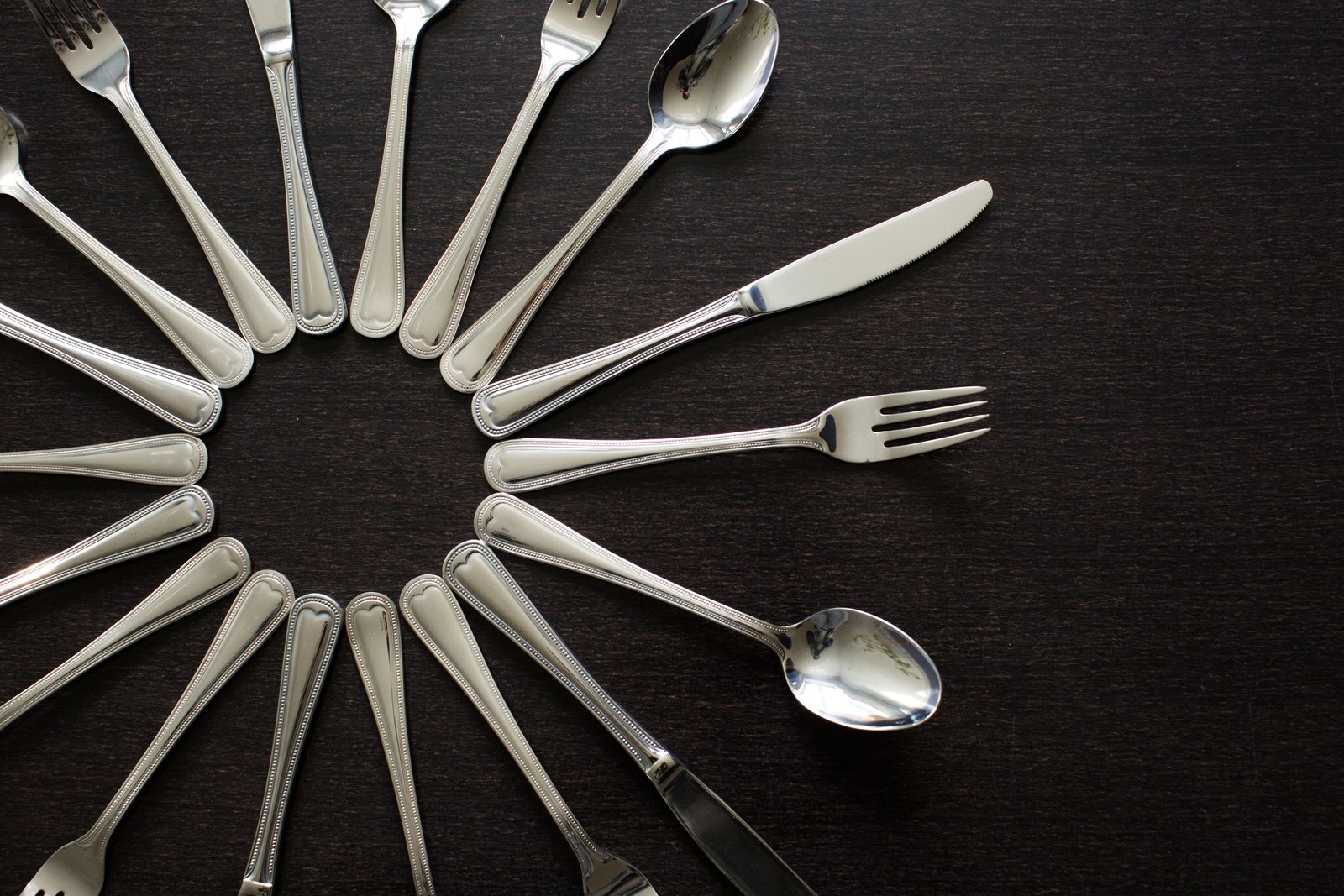
The path to sustainable annealing is paved with obstacles that require careful consideration and innovative solutions. These challenges span technological limitations of older equipment, the chemical by-products of imperfect processes, and the economic realities of investing in new technologies. For many metal processors, especially those dealing with high-volume production of stainless steel strip, carbon steel strip, or copper alloys, these issues are daily concerns. At AKS Furnace, we've dedicated significant R&D efforts to address these very challenges, focusing on creating annealing furnaces that are not only high-performing but also inherently more energy-efficient and environmentally sound. Understanding the nuances of these hurdles allows us to better tailor our solutions, like our customizable Bright Annealing Furnaces, to meet the specific sustainability goals of our diverse clientele, from automotive part producers to electronics hardware manufacturers. The transition requires a blend of technological advancement, process optimization, and strategic financial planning.
High Energy Consumption and Thermal Inefficiencies
One of the most significant challenges in traditional annealing processes is their inherently high energy consumption. Older furnace designs often suffer from poor insulation, leading to substantial heat loss to the surrounding environment. I've visited plants where you could feel the radiant heat several meters away from an old batch furnace, a clear sign of wasted energy. Furthermore, outdated burner technology in gas-fired furnaces or inefficient heating elements in electric furnaces contribute to lower thermal efficiency, meaning more fuel or electricity is consumed per ton of metal processed. For instance, a study by the Centre for Industrial Energy, Materials and Products (CIEMAP) has shown that optimizing industrial heating processes can yield energy savings from 5% to over 20%6, depending on the existing technology and interventions.
Heat loss also occurs through exhaust gases. In many conventional furnaces, hot flue gases are vented directly into the atmosphere, carrying away a significant amount of thermal energy. Without effective heat recovery systems (like recuperators or regenerators that preheat combustion air or the incoming workload), this energy is simply wasted. The thermal mass of the furnace itself, including refractory linings and support structures, can also contribute to inefficiencies, especially in batch processes where the furnace must be repeatedly heated and cooled. This cycling consumes additional energy and can also reduce the lifespan of furnace components.
Moreover, achieving and maintaining precise temperature uniformity within the annealing chamber can be challenging with older systems, potentially leading to longer cycle times to ensure all parts of the workload reach the target temperature. This extended exposure at high temperatures not only consumes more energy but can also negatively impact material properties if not carefully controlled. Our modern AKS furnace designs specifically address these issues through features like advanced ceramic fiber insulation, high-velocity burners for better heat distribution, and sophisticated PLC-based temperature control systems to optimize heating profiles and minimize energy usage. For example, our continuous bright annealing lines for stainless steel strip are designed for optimal heat transfer and minimal thermal inertia, allowing for quicker startups and more responsive temperature adjustments.
Atmospheric Control and By-product Management
Maintaining the integrity of the protective atmosphere within an annealing furnace is crucial for achieving the desired surface finish (especially for bright annealing) and preventing undesirable metallurgical reactions like oxidation or decarburization. However, achieving and sustaining this precise atmospheric control can be a significant challenge, particularly in older or poorly sealed furnaces. Air ingress due to leaky seals or improper purging can contaminate the protective atmosphere (typically hydrogen, nitrogen, or a mixture), leading to surface oxidation on materials like stainless steel or copper. This oxidation then necessitates aggressive post-annealing cleaning processes, most commonly chemical pickling. Pickling uses strong acids (e.g., nitric acid, hydrofluoric acid for stainless steel) which are hazardous, corrosive, and generate toxic fumes and liquid waste requiring complex treatment7. I remember a client producing copper strips who struggled with persistent surface tarnishing due to poor atmosphere control in their old furnace, leading to high rejection rates and the added expense of a secondary chemical cleaning step. Transitioning to an AKS furnace with a gas-tight muffle and precise atmosphere monitoring system eliminated this issue.
Even the protective gases themselves can pose challenges. For example, if hydrogen is used, ensuring its safe handling and preventing leaks is paramount. If dissociated ammonia is used as a source of hydrogen and nitrogen, incomplete cracking can lead to residual ammonia in the furnace atmosphere, which can be detrimental to certain alloys or cause nitriding. Furthermore, if hydrocarbon-based gases are used for generating a reducing atmosphere, incomplete combustion can lead to soot formation or emissions of volatile organic compounds (VOCs) and carbon monoxide (CO), which are regulated pollutants.
The by-products of these processes, whether it's the scale removed by pickling or the sludge from wastewater treatment, represent not only an environmental burden but also a loss of valuable material and an added operational cost. The drive towards sustainability in annealing is therefore heavily focused on technologies like bright annealing that minimize or eliminate the formation of these undesirable surface layers in the first place, thus obviating the need for such problematic downstream processes.
| Parameter | Poor Atmosphere Control | Optimal Atmosphere Control (e.g., Bright Annealing) |
|---|---|---|
| Surface Oxidation Level | High (e.g., >100 Å on stainless steel) | Minimal/None (e.g., <10 Å on stainless steel) |
| Need for Pickling | Essential | Eliminated or significantly reduced |
| Acid Consumption (kg/ton) | Significant (e.g., 10-50 kg/ton for SS) | Negligible / Zero |
| Sludge Generation (kg/ton) | Substantial (e.g., 5-20 kg/ton from pickling) | Negligible / Zero |
| Material Loss due to Scale/Pickling | 1-5% or more | <0.1% |
| Product Surface Quality | Dull, requires further finishing | Bright, often ready for next process/sale |
| Protective Gas Efficiency | Lower due to contamination/losses | Higher due to better sealing and control |
Economic and Implementation Hurdles
While the long-term benefits of sustainable annealing technologies are clear, the initial economic investment and implementation challenges can be significant barriers for many companies. Upgrading to modern, energy-efficient bright annealing furnaces or retrofitting existing lines with advanced control systems and heat recovery units requires substantial capital expenditure. For small and medium-sized enterprises (SMEs), which form a large part of the metal processing industry, securing the necessary financing for such upgrades can be difficult, especially when competing with other operational priorities. I've seen businesses continue with older, less efficient equipment simply because the upfront cost of replacement seemed prohibitive, despite the higher ongoing operational costs.
Beyond the initial purchase price, there are costs associated with installation, commissioning, and potentially redesigning the plant layout to accommodate new equipment. Retrofitting existing lines can also be complex, involving significant downtime which impacts production. There's also the "perceived risk" factor; some companies may be hesitant to adopt newer technologies if they lack in-house expertise or are unsure about the reliability and return on investment.
Furthermore, the successful implementation of advanced annealing technologies requires a skilled workforce. Operators and maintenance staff need to be trained to manage sophisticated control systems, handle specialized atmospheres like hydrogen safely, and perform predictive maintenance to ensure optimal efficiency. A lack of readily available skilled personnel can be a hurdle, particularly in some regions. At AKS, we try to mitigate these challenges by offering comprehensive technical support, training programs for client staff, and customizable furnace solutions that can sometimes be phased in to manage investment. We also work with clients to develop strong business cases that highlight the long-term ROI, considering energy savings, reduced waste disposal costs, improved material yield, and enhanced product quality, which often offset the initial investment over a predictable period.
Bright annealing reduces chemical cleaning needsTrue
Proper bright annealing maintains protective atmospheres that prevent oxidation, eliminating the need for subsequent acid pickling processes.
Old furnaces are more energy efficientFalse
Older furnace designs typically have poor insulation and outdated heating technology, making them significantly less energy efficient than modern designs.
Role of Bright Annealing in Overcoming Sustainability Challenges
Are you grappling with the environmental impact and inefficiencies of conventional annealing, particularly the subsequent need for chemical cleaning? Traditional methods frequently result in significant surface oxidation, leading to material loss, increased energy consumption for cleaning, and the generation of hazardous waste. Bright annealing, however, offers a direct and effective solution, fundamentally minimizing environmental impact while simultaneously enhancing operational efficiency and product quality.
Bright annealing significantly overcomes sustainability challenges by utilizing precisely controlled protective atmospheres (typically hydrogen, nitrogen-hydrogen mixtures, or dissociated ammonia) to prevent surface oxidation during the heat treatment cycle. This eliminates the need for harmful chemical pickling, reduces material loss, conserves energy, and improves overall process efficiency.
As we've explored the array of challenges inherent in making annealing processes truly sustainable, it has become abundantly clear that innovative, targeted solutions are not just beneficial but paramount for progress. This is precisely the context in which bright annealing emerges as a genuinely transformative technology. By fundamentally altering the approach to surface protection during the critical heat treatment phase, bright annealing directly addresses many of the most pressing environmental and efficiency-related pain points that are commonly associated with conventional annealing methods. At AKS Furnace, we have consistently championed bright annealing technology because we have witnessed firsthand its profound and positive impact across a diverse range of applications and industries. Consider, for instance, a valued client of ours in Southeast Asia who specializes in producing high-grade stainless steel strips for the demanding electronics and white goods sectors. Before partnering with us, they constantly battled with inconsistent surface quality from their older annealing line, which necessitated extensive pickling. This not only led to high consumption of pickling acids and the associated costs of hazardous waste disposal but also negatively impacted their material yield and energy footprint. By strategically transitioning to one of our state-of-the-art Bright Annealing Furnaces, they achieved a consistently superior, mirror-like bright finish directly from the furnace. This eliminated their entire pickling operation, drastically cut their chemical usage and waste, reduced material losses, and significantly improved their overall energy efficiency. This isn't merely a marginal improvement; it represents a significant leap towards cleaner, more responsible production, aligning perfectly with global sustainability mandates and delivering tangible economic benefits that strengthen their competitive edge. The core principle underpinning bright annealing's success – preventing oxidation meticulously, rather than attempting to correct its detrimental effects later – is the key to its outstanding eco-friendly credentials and its role as a cornerstone of sustainable metal processing.

Bright annealing stands out as a pivotal technology in the quest for sustainable metal processing. Its inherent characteristics directly counter many of the environmental and operational drawbacks of older annealing techniques. By creating a finished product that is clean, bright, and often ready for immediate downstream processing or sale, bright annealing minimizes waste, conserves resources, and reduces the overall environmental burden. At AKS Furnace, our range of bright annealing solutions, including continuous lines for strip and wire, and bell-type furnaces for coils, are designed to maximize these benefits for materials like stainless steel, carbon steel, copper, and aluminum. We've seen clients, such as manufacturers of automotive exhaust components or producers of precision electronic terminals, achieve remarkable improvements in both their environmental performance and product quality by adopting this technology. The shift to bright annealing is a strategic move towards a more efficient, cleaner, and ultimately more profitable manufacturing future.
Elimination of Chemical Pickling and Associated Waste
The most significant sustainability advantage of bright annealing lies in its ability to prevent surface oxidation, thereby largely or completely eliminating the need for subsequent chemical pickling. In conventional annealing processes, especially for materials like stainless steel, exposure to even trace amounts of oxygen at high temperatures leads to the formation of oxide scales on the metal surface. These scales are undesirable as they affect the appearance, corrosion resistance, and further processability of the material. Consequently, they must be removed, typically through immersion in aggressive acid baths (e.g., mixtures of nitric acid and hydrofluoric acid for stainless steels, or sulfuric acid for carbon steels)8. This pickling process is fraught with environmental challenges. The acids themselves are hazardous, posing risks to worker safety and requiring careful handling and storage. The process generates toxic fumes that must be managed. More critically, it produces large volumes of spent acid and acidic rinse water, contaminated with dissolved heavy metals, which constitute hazardous waste. Treating and disposing of this waste is expensive, energy-intensive, and carries significant environmental liability. I recall a client who manufactured decorative stainless steel tubes; their pickling bay was a major operational bottleneck and a constant source of environmental compliance headaches, not to mention the unpleasant working conditions.
Bright annealing, by contrast, operates under a precisely controlled protective atmosphere – commonly pure hydrogen, a nitrogen-hydrogen mixture (forming gas), or dissociated ammonia (which cracks into a 75% H2, 25% N2 mixture). These reducing or inert atmospheres prevent oxygen and other reactive gases from coming into contact with the hot metal surface. As a result, the material emerges from the furnace with a clean, bright, oxide-free surface. This directly obviates the need for pickling. The benefits are manifold:
- No hazardous acid usage: Eliminates the purchase, storage, handling, and disposal of large quantities of dangerous chemicals.
- No toxic fumes: Improves workplace air quality and eliminates atmospheric pollution from acid vapors.
- No hazardous liquid waste: Eradicates the generation of spent pickling acids and contaminated rinse water, significantly reducing waste treatment costs and environmental impact. For example, data from stainless steel processors often shows that pickling can account for 5-10% of the total processing cost9 when all factors (chemicals, waste treatment, labor, material loss) are considered. Eliminating this step represents a huge saving.
- Reduced water consumption: As rinsing after pickling is no longer required, water usage associated with this step is eliminated.
One of our clients, a manufacturer of high-quality stainless steel kitchenware (a key target for AKS), was able to completely decommission their entire pickling and subsequent neutralization plant after installing one of our continuous mesh belt bright annealing furnaces. They reported an immediate reduction in their hazardous waste manifest by over 90% and significant improvements in plant safety.
Enhanced Energy Efficiency and Reduced Emissions
While the primary focus of bright annealing is surface quality and elimination of pickling, modern bright annealing furnaces also contribute to enhanced energy efficiency and reduced overall emissions. This is achieved through several mechanisms. Firstly, advanced furnace designs incorporate superior insulation materials (e.g., multi-layer ceramic fiber insulation), optimized heating element configurations (for electric furnaces) or high-efficiency burners with heat recovery systems (for gas-fired furnaces), and gas-tight construction (often using muffles or retorts made from heat-resistant alloys like Inconel or Cr-Ni steels). These features minimize heat losses to the environment and ensure that more of the energy input is used effectively to heat the product. For instance, some of our AKS muffle-type bright annealing furnaces for stainless steel strip are designed with counter-flow heat exchange principles, where the outgoing hot strip preheats the incoming cold strip (indirectly through the muffle or atmosphere), thereby recovering a portion of the process heat.
Secondly, by eliminating the need for post-annealing cleaning processes like pickling, the energy associated with those downstream operations is also saved. Pickling baths often need to be heated, and the subsequent rinsing, neutralization, and wastewater treatment processes all consume energy. Therefore, the overall energy footprint per ton of finished product is reduced.
Thirdly, the precise atmosphere control in bright annealing can sometimes allow for optimized annealing cycles. Because the surface remains clean, heat transfer can be more efficient and consistent. While the protective atmosphere itself requires energy (e.g., for hydrogen generation or purification), modern systems are designed to minimize gas consumption through effective sealing, atmosphere recycling (in some larger installations), and precise flow control linked to oxygen sensors (dew point analyzers) that ensure only the necessary amount of reducing gas is used. Comparing the total energy consumption of a conventional anneal-and-pickle line versus an integrated bright annealing line for, say, stainless steel coils, studies and client feedback often indicate a net energy saving of 10-25% for the bright annealing route, depending on the specific setup and efficiency of the older line. This reduction in energy consumption directly translates to lower greenhouse gas emissions, especially if the energy source is fossil fuel-based.
| Parameter | Conventional Anneal + Pickle | Bright Annealing (AKS Furnace example) |
|---|---|---|
| Energy for Annealing (kWh/ton) | Variable, potentially higher due to less optimized older designs | Optimized design, potentially 10-20% lower |
| Energy for Pickling (kWh/ton) | 50 - 150 (heating, pumping, agitation) | 0 (process eliminated) |
| Energy for Waste Treatment (kWh/ton) | 20 - 80 (neutralization, sludge dewatering) | 0 (waste stream eliminated) |
| Total Indicative Energy (kWh/ton) | Sum of above | Annealing energy only |
| CO2 Emissions (kg/ton, grid avg.) | Higher due to higher total energy | Lower due to lower total energy |
| Water for Pickling/Rinsing (m³/ton) | 5 - 20 | 0 |
| Acid Consumption (kg/ton) | 10 - 50 (e.g., for stainless steel) | 0 |
| Hazardous Waste (kg/ton) | 5 - 25 (sludge, spent acid) | 0 |
(Note: Values are indicative and can vary widely based on specific materials, equipment efficiency, and operational practices. The table illustrates comparative advantages.)
Improved Material Yield and Product Quality
Beyond the direct environmental benefits, bright annealing significantly contributes to sustainability by improving material yield and overall product quality, which reduces waste and the need for rework. In conventional annealing, the formation of oxide scale represents a direct loss of valuable metal. This scale has to be removed, and the pickling process itself can also lead to a slight dissolution of the base metal, further reducing yield. For expensive materials like stainless steels, nickel alloys, or even high-quality copper alloys, this material loss can be economically significant. For example, scale formation can account for a 1-3% loss in material yield, and aggressive pickling can add to this. Bright annealing, by preventing scale formation, ensures that virtually 100% of the input material becomes finished product, maximizing resource utilization.
The consistent, high-quality bright surface finish achieved directly from the furnace is another major advantage. This often eliminates the need for subsequent mechanical polishing or buffing operations, which are labor-intensive, consume energy, and can generate dust or abrasive waste. For applications where a pristine surface is critical – such as in electronics (e.g., terminals, connectors made from bright annealed copper alloys), medical devices, automotive components (e.g., bright annealed stainless steel for exhaust systems or fuel lines), or decorative items (e.g., white goods and kitchenware) – bright annealing delivers a product that is often ready for the next manufacturing step or even for final assembly without further surface treatment.
This enhanced product quality also leads to reduced rework and scrap rates. Inconsistent surface finishes, residual scale, or over-pickling defects from conventional processes can lead to parts being rejected, requiring them to be reprocessed or scrapped entirely. Each rejected part represents wasted material, energy, and labor. By providing a highly consistent and predictable surface quality, bright annealing helps to improve first-pass yield rates, contributing to leaner and more sustainable manufacturing. I've seen this firsthand with clients producing precision stainless steel tubes for the automotive sector; switching to an AKS bright annealing line drastically reduced their surface defect-related scrap by over 70%, which had a direct positive impact on their material costs and overall efficiency. The enhanced corrosion resistance of a clean, smooth, bright-annealed surface can also contribute to longer product life, which is another aspect of sustainability.
Bright annealing prevents surface oxidationTrue
Bright annealing uses protective atmospheres to prevent oxygen contact with metal surfaces during heat treatment.
Bright annealing requires chemical picklingFalse
One of bright annealing's main advantages is eliminating the need for chemical pickling by preventing oxidation.
Strategies for Leveraging Bright Annealing for Sustainable Outcomes
So you're considering or have already adopted bright annealing – that's a great step! But are you truly maximizing its potential for sustainable manufacturing? Simply installing a bright annealing furnace is only part of the equation; to achieve optimal green results and fully capitalize on its benefits, strategic implementation, process integration, and continuous optimization are absolutely key.
Leveraging bright annealing for maximum sustainable outcomes involves meticulous selection of the furnace design tailored to specific materials and production needs, precise optimization of protective atmosphere composition and flow rates, integration with upstream and downstream processes to eliminate redundant steps, implementation of heat recovery systems, and a commitment to regular maintenance and continuous improvement for peak energy efficiency and consistent performance.
Adopting bright annealing technology marks a significant stride towards more sustainable metal processing, but fully realizing its comprehensive environmental and economic advantages necessitates a thoughtful and strategic approach that extends far beyond the initial equipment installation. It’s not merely about acquiring a new piece of machinery; it’s about intelligently integrating this advanced technology into your entire production ecosystem to create synergistic benefits. At AKS Furnace, our engagement with clients doesn't conclude with the commissioning of a furnace. We see it as the beginning of a partnership aimed at continuous optimization. For instance, I recently worked with a prominent stainless steel wire producer in India who was targeting the highly competitive and environmentally conscious European export market. They required not only a flawless bright finish for their high-tensile stainless steel wire but also verifiable proof of minimal environmental impact to satisfy their discerning buyers. Our collaboration involved more than just supplying one of our specialized bright annealing furnaces for wire. We delved deep into their entire annealing line, working with their team to meticulously optimize the hydrogen-nitrogen gas mixture control, analyze dew point for maximum efficiency, explore options for utilizing waste heat from the furnace's cooling zones to preheat process water, and streamline material flow to reduce handling. This holistic view ensures that the bright annealing furnace doesn’t just operate as an isolated, efficient unit but functions as a pivotal, integrated component in a genuinely sustainable manufacturing strategy. This comprehensive approach involves careful upfront planning, ongoing performance monitoring with key metrics, and an unwavering commitment to process optimization, ensuring that the technology consistently delivers on its green promise effectively and contributes positively to the bottom line.
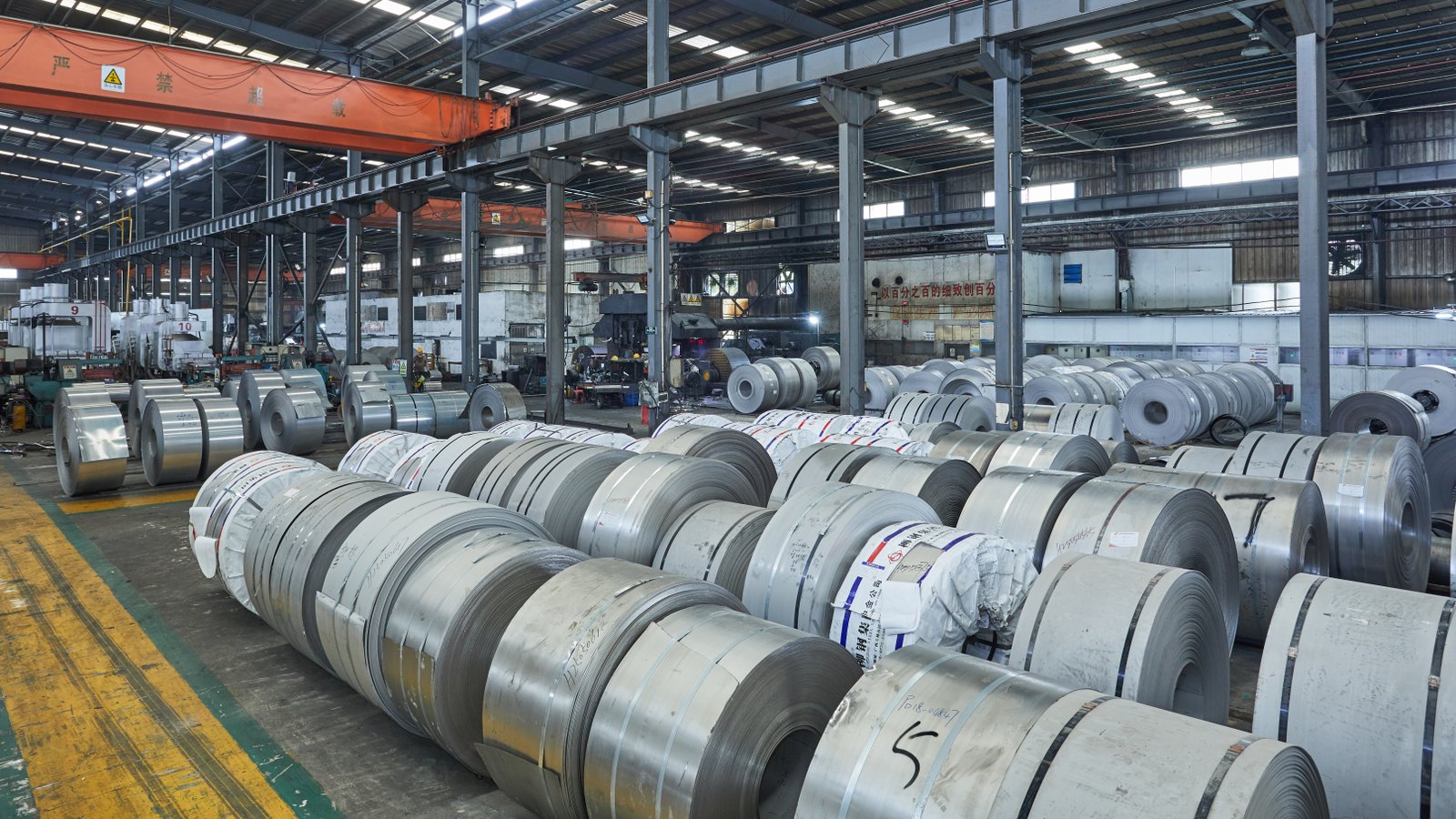
To truly harness the power of bright annealing for sustainability, a multi-faceted strategy is essential. This involves not only choosing the right equipment but also optimizing its operation, integrating it seamlessly with other production stages, and fostering a culture of continuous improvement. For our clients at AKS Furnace, whether they are processing stainless steel strip, carbon steel coils, copper tubes, or aluminum foil, we emphasize that the journey to sustainable outcomes is ongoing. It requires attention to detail, from the chemistry of the protective atmosphere to the efficiency of heat recovery systems. By focusing on these strategic areas, manufacturers can ensure their investment in bright annealing technology translates into measurable improvements in energy efficiency, waste reduction, material yield, and overall environmental performance, ultimately enhancing their competitiveness and corporate responsibility.
Optimizing Furnace Design and Operational Parameters
The first crucial step in leveraging bright annealing for sustainability is selecting the optimal furnace design and then fine-tuning its operational parameters for your specific application. Not all bright annealing furnaces are created equal, and the best choice depends heavily on the material being processed, the required throughput, and the desired surface characteristics. For example, for continuous annealing of stainless steel strip or wire, a muffle-type furnace (where the strip passes through a sealed, heated alloy muffle containing the protective atmosphere) or a direct-fired furnace with highly controlled atmosphere integrity is often preferred. Our AKS Bright Annealing Furnaces for strip and wire are engineered with this in mind, focusing on rapid heat transfer and precise atmosphere control. For batch annealing of coils, a Bell-Type Annealing Furnace, known for its excellent atmosphere tightness and temperature uniformity, is a more suitable choice. We offer these for clients processing coils of carbon steel or non-ferrous metals. Customizing the furnace selection ensures that you are not over-specifying (and thus wasting energy on unused capacity) or under-specifying (leading to quality issues or bottlenecks).
Once the furnace is selected, optimizing operational parameters is key. This includes the composition of the protective atmosphere. Pure hydrogen is an excellent reducing agent and produces the brightest finishes on stainless steel, but it can be costly and requires stringent safety protocols. Nitrogen-hydrogen mixtures (forming gas, typically 5-25% H2 in N2) are often a more economical and safer alternative for many applications, though they may require slightly higher dew points (moisture content) to be effective. Dissociated ammonia (cracked into 75% H2, 25% N2) is another common choice, particularly in regions where hydrogen availability is limited or expensive. We work with clients to determine the ideal gas mixture for their specific material grade (e.g., austenitic vs. ferritic stainless steels, different copper alloys) and desired brightness, balancing cost, safety, and effectiveness. For instance, precise control of the atmosphere dew point is critical; too high a dew point leads to oxidation, while too low (overly dry) can sometimes be less effective or unnecessarily costly in terms of gas purification. Modern bright annealing lines often incorporate sophisticated dew point sensors and automated flow control systems to maintain the atmosphere within a very narrow optimal window. A study published in the Journal of Materials Processing Technology highlighted that dew point control to below -40°C10 is often necessary for achieving optimal brightness on Cr-containing steels, and this can significantly impact hydrogen consumption if not managed precisely.
Precise temperature control and cycle optimization are also vital. This means ensuring uniform heating to the correct annealing temperature, holding for the minimum time required to achieve the desired metallurgical properties, and then cooling efficiently under protective atmosphere. Overheating or excessively long soak times waste energy and can lead to grain growth or other undesirable microstructural changes. Our AKS furnaces utilize advanced PLC-based control systems with multiple heating zones and precise thermocouple feedback to ensure accurate temperature profiles, minimizing energy consumption per unit of product.
Integrating with Upstream and Downstream Processes
To maximize the sustainable benefits of bright annealing, it’s essential to consider its integration with both upstream and downstream manufacturing processes. What happens before the material enters the furnace and after it leaves can significantly impact the overall efficiency and environmental footprint.
Upstream, proper pre-cleaning of materials is crucial. While bright annealing prevents further oxidation, it generally does not remove existing surface contaminants like oils, lubricants from drawing or rolling, dirt, or heavy oxides from previous hot working stages. These contaminants can vaporize in the furnace, react with the protective atmosphere, or deposit on the furnace internals or the material surface, leading to defects, reduced brightness, or increased consumption of protective gas. Implementing effective pre-cleaning steps (e.g., degreasing, alkaline washing) ensures that the material enters the bright annealing furnace in an optimal condition, maximizing the effectiveness of the process and reducing the risk of contamination. This not only improves product quality but also prolongs the life of furnace components like muffles and heating elements. I recall a client processing small automotive components who saw a dramatic improvement in brightness consistency and a reduction in furnace maintenance after they upgraded their pre-cleaning line based on our recommendations.
Downstream, the clean, bright surface produced by the annealing process can often streamline or eliminate subsequent operations. For example, if the bright annealed material has a sufficiently good surface finish, it may not require further polishing or buffing, saving energy, labor, and consumables. The improved ductility and formability resulting from proper annealing can also enhance the efficiency of subsequent forming operations (e.g., deep drawing, bending), potentially reducing tool wear and reject rates. By considering the entire production flow, manufacturers can identify opportunities to leverage the benefits of bright annealing to create a leaner, more integrated, and more sustainable overall process. For example, an automotive component manufacturer might integrate an AKS continuous bright annealing furnace directly into their tube forming and cutting line, creating a continuous flow that minimizes intermediate handling, storage, and potential for surface damage or contamination, thus eliminating several intermediate cleaning and buffering steps.
| Integration Point | Key Consideration | Sustainability Impact |
|---|---|---|
| Pre-Treatment | Thorough cleaning (degreasing, washing) of incoming material | Prevents furnace contamination, ensures consistent brightness, reduces gas consumption |
| Material Input | Consistent material quality and dimensions | Optimizes furnace loading, ensures uniform heating and atmosphere exposure |
| Atmosphere Supply | Reliable, pure gas source; proper dew point control | Maximizes brightness, minimizes gas usage, prevents surface defects |
| Furnace Loading | Maximize load density (batch) or continuous throughput | Improves energy efficiency per unit of product |
| Post-Treatment | Direct integration to next process (e.g., forming, coating) | Eliminates intermediate storage/handling, reduces potential for damage/contamination |
| Heat Recovery | Capture waste heat from cooling zones or flue gases | Preheats combustion air, process water, or facility heating, reducing overall energy demand |
| Data Logging | Monitor key parameters (temp, gas flow, dew point) | Enables process optimization, predictive maintenance, quality assurance |
Implementing Continuous Improvement and Monitoring
The journey towards sustainable manufacturing via bright annealing doesn't end with installation and initial optimization. A commitment to continuous improvement and diligent monitoring is essential to maintain peak performance and identify further opportunities for energy savings and waste reduction over time. This involves establishing regular maintenance schedules for the furnace and its ancillary equipment. Key maintenance activities include checking and replacing door seals and muffle integrity to prevent atmosphere leaks, inspecting and cleaning heating elements or radiant tubes, calibrating temperature sensors and atmosphere analyzers (like dew point meters and oxygen sensors), and ensuring the proper functioning of cooling systems. Proactive and predictive maintenance, guided by sensor data and operational history, can prevent unexpected breakdowns, maintain optimal energy efficiency, and extend the lifespan of the equipment. At AKS, we provide detailed maintenance guidelines and technical service to support our clients in this.
Monitoring key performance indicators (KPIs) is crucial. This includes tracking energy consumption (kWh or m³/BTU per ton of product), protective gas usage (m³ per ton), water consumption (if applicable for cooling), and product quality metrics (brightness, rejection rates). Regularly analyzing this data can help identify trends, pinpoint inefficiencies, and measure the impact of any process changes. For example, a gradual increase in gas consumption might indicate a developing leak in the furnace seals or muffle, prompting a maintenance check.
Training personnel on sustainable operation practices is also vital. Operators should understand the importance of maintaining correct parameters, the impact of their actions on energy and gas consumption, and basic troubleshooting. Fostering a culture where employees are encouraged to suggest improvements can also yield significant benefits. Finally, actively exploring opportunities for heat recovery is a significant step. Waste heat from furnace cooling zones or flue gases (in gas-fired units) can often be captured and utilized for other plant processes, such as preheating combustion air for burners (using recuperators), preheating incoming material, providing hot water for cleaning, or even for space heating in colder climates. We often discuss these possibilities with clients during the
initial design phase or as potential upgrades. For instance, one of our larger clients successfully implemented a system to use waste heat from their continuous bright annealing line's cooling section to preheat water for their component washing line, reducing the energy needed for water heating by over 40%.
Bright annealing requires strategic integrationTrue
Simply installing a bright annealing furnace is insufficient; optimal results require careful process integration and continuous optimization.
Pure hydrogen is always best for bright annealingFalse
While pure hydrogen produces excellent results, nitrogen-hydrogen mixtures are often more economical and safer alternatives for many applications.
Conclusion
Ultimately, bright annealing is a cornerstone technology for achieving sustainable manufacturing in metal processing. It directly tackles energy use, waste generation, and material efficiency, aligning operational excellence with vital environmental stewardship for a greener industrial future.
-
Understand the Triple Bottom Line framework and how it integrates social, environmental, and financial performance. ↩
-
Access the Bloomberg Intelligence report on projected growth of global ESG assets and its market impact. ↩
-
Learn about the EU's CBAM, its objectives, and implications for international trade and emissions. ↩
-
circular economy for metals ↩
-
waste heat recovery systems ↩
-
optimizing industrial heating processes can yield energy savings from 5% to over 20% ↩
-
toxic fumes and liquid waste requiring complex treatment ↩
-
aggressive acid baths (e.g., mixtures of nitric acid and hydrofluoric acid for stainless steels, or sulfuric acid for carbon steels) ↩
-
pickling can account for 5-10% of the total processing cost ↩
-
dew point control to below -40°C ↩
Have Questions or Need More Information?
Get in touch with us for personalized assistance and expert advice.
